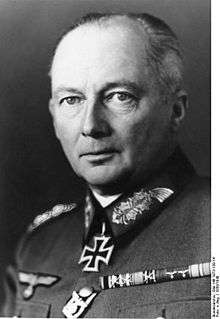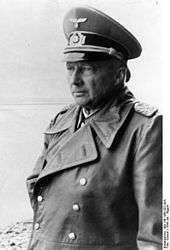Günther von Kluge
| Günther "Hans" von Kluge | |
|---|---|
 Generalfeldmarschall Günther von Kluge | |
| Nickname(s) | Der kluge Hans |
| Born |
30 October 1882 Posen, Province of Posen, Kingdom of Prussia, German Empire now Poznań, Greater Poland, Poland |
| Died |
19 August 1944 (aged 61) Metz, Gau Westmark, Nazi Germany now Metz, Lorraine, France |
| Allegiance |
|
| Service/branch |
German Army 1901–19 Reichswehr 1919–35 Wehrmacht 1935–44 |
| Years of service | 1901–44 |
| Rank | Generalfeldmarschall |
| Unit |
46th Field Artillery Regiment XXI Corps |
| Commands held |
4th Army Army Group Centre |
| Battles/wars | |
| Awards | Knight’s Cross of the Iron Cross with Oak Leaves and Swords |
| Relations | Wolfgang von Kluge (brother) |
Günther von Kluge (30 October 1882 – 19 August 1944) was a German field marshal during World War II. Kluge held commands on both the Eastern and Western Fronts and was awarded the Knight's Cross of the Iron Cross with Oak Leaves and Swords. Although Kluge was not an active conspirator in the 20 July plot, he committed suicide on 19 August 1944, after having been recalled to Berlin for a meeting with Hitler in the aftermath of the failed coup. He was replaced by Field Marshal Walter Model.
Early career
Günther von Kluge, son of Generalmajor Max von Kluge, joined the Imperial German Army in 1901 and served in the 46th Field Artillery Regiment. During World War I he was a staff officer in the XXI Corps; and remained in the Reichswehr after the war.
Invasion of Poland and France
He took part in the invasion of Poland in 1939 as commander of the 4th Army. He had a central role in the death sentences for twenty-eight Polish prisoners taken in the Defense of the Polish Post Office in Danzig. Though he opposed the initial German plan to attack westwards into France, he led the Fourth Army in its attack through the Ardennes that culminated in the fall of France. Kluge was promoted to field marshal in July 1940.
Soviet Union

Kluge commanded the 4th Army at the opening of Operation Barbarossa, where he developed a strained relationship with Heinz Guderian over tactical issues in the advance, accusing Guderian of frequent disobedience of his orders. On 29 June Kluge ordered that, ‘Women in uniform are to be shot.’[1]
After Fedor von Bock was relieved of his command of Army Group Center in late 1941, Kluge was promoted and led that army group until he was injured in October 1943. Kluge frequently rode in an airplane to inspect the divisions under his command and sometimes relieved his boredom during the flights by shooting foxes from the air[2]—a decidedly non-traditional method. On 30 October 1942 Kluge was the beneficiary of an enormous bribe from Hitler, who mailed him a letter of good wishes together with a huge cheque made out to him from the German treasury and a promise that whatever improving his estate might cost could be billed out to the German treasury.[3] Kluge took the money, but after receiving severe criticism from his Chief of Staff, Henning von Tresckow, who upbraided him for corruption, he agreed to meet Carl Friedrich Goerdeler in November 1942.[4] Kluge promised Goerdeler that he would arrest Hitler the next time he came to the Eastern Front, but then after receiving another "gift" from Hitler he changed his mind and decided to stay loyal.[5] Hitler, who seems to have heard that Kluge was dissatisfied with his leadership, regarded his "gifts" as entitling him to Kluge's total loyalty.[5] On 27 October 1943 Kluge was badly injured when his car overturned on the Minsk–Smolensk road. He was unable to return to duty until July 1944. After his recovery he became commander of the German forces in the West (Oberbefehlshaber West) as Gerd von Rundstedt’s replacement.
France and the Western Front
Between June and July 1944, during the invasion of Normandy by Allied forces, Rommel commanded Army Group B under Field Marshal von Rundstedt. Rommel was charged with planning German counterattacks intended to drive the Allied forces back to the beaches. On 5 July Kluge replaced Rundstedt, because Rundstedt was advocating negotiation with the Allies. Two weeks later, Rommel was wounded and Kluge took over as commander of Army Group B as well, where Kluge's forces around the town of Falaise were encircled by combined U.S., Canadian, British, and Polish armies.
In August, after the failed coup attempt by Stauffenberg, Kluge was recalled to Berlin and replaced by Model.
Kluge's nickname among the troops and his fellow officers was der kluge Hans ("Clever Hans"). This nickname was acquired early in his career, partly in admiration of his cleverness and partly as a pun on his name (klug is German for "clever"). The "Hans" component came not from any of his given names but from Clever Hans, a horse which became famous for its apparent ability to do arithmetic.
Kluge and 20 July plot

A leading figure of the German military resistance, Henning von Tresckow, served as his Chief of Staff of Army Group Centre. Kluge was somewhat involved in the military resistance. He knew about Tresckow’s plan to shoot Hitler during a visit to Army Group Centre, having been informed by his former subordinate, Georg von Boeselager, who was now serving under Tresckow. At the last moment, Kluge aborted Tresckow's plan. Boeselager later speculated that because Heinrich Himmler had decided not to accompany Hitler, Kluge feared that without eliminating Himmler too, it could lead to a civil war between the SS and the Wehrmacht.[6]
When Stauffenberg attempted to assassinate Hitler on 20 July, Kluge was Oberbefehlshaber West ("Supreme Field Commander West") with his headquarters in La Roche-Guyon. The commander of the occupation troops of France, General Carl-Heinrich von Stülpnagel, and his colleague Colonel Cäsar von Hofacker – a cousin of Stauffenberg – came to visit Kluge. Stülpnagel had just ordered the arrest of the SS units in Paris. Kluge had already learned that Hitler had survived the assassination attempt and refused to provide any support. "Ja – wenn das Schwein tot wäre!" ("Yes – if the pig were dead!)" he said.[7] On 17 August he was replaced by Walter Model and recalled to Berlin for a meeting with Hitler after the coup failed; thinking that Hitler would punish him as a conspirator, he committed suicide by taking cyanide near Metz two days later on 19 August. He left Hitler a letter in which he advised him to make peace, and to show "the greatness that will be needed to put an end to a hopeless struggle." Hitler reportedly handed the letter to Alfred Jodl and commented that "There are strong reasons to suspect that had not Kluge committed suicide he would have been arrested anyway."[8] SS officer Jürgen Stroop boasted of his involvement in investigating Kluge for involvement in the plot. He claimed to have offered the Field Marshal the opportunity to commit suicide, but that Kluge refused. He then claimed to have personally shot him and that Himmler had ordered him to announce that Kluge had committed suicide.[9]
Dates of rank

- Generalmajor – 1 February 1933
- Generalleutnant – 1 April 1934
- General der Artillerie – 1 August 1936
- Generaloberst – 1 October 1939
- Generalfeldmarschall – 19 July 1940
Awards
- Iron Cross (1914) 2nd and 1st class
- House Order of Hohenzollern Knight's Cross with Swords
- Bavarian Military Merit Order, 4th class with Swords
- Knight's Cross of the Iron Cross with Oak Leaves and Swords
- Mentioned four times in the Wehrmachtbericht (6 August 1941, 7 August 1941, 18 October 1941, 19 October 1941, 3 September 1943)[11]
References
Citations
- ↑ Nor, Johnathan, Soviet Prisoners of War: Forgotten Nazi Victims of World War II, http://www.historynet.com/wars_conflicts/world_war_2/3037296.html
- ↑ Hoffmann 1977, p. 276.
- ↑ Wheeler-Bennett 1953, p. 529.
- ↑ Wheeler-Bennett 1953, pp. 529–530.
- 1 2 Wheeler-Bennett 1953, p. 530.
- ↑ Knopp 2007, p. 226.
- ↑ Knopp 2007, p. 251.
- ↑ Shirer 1990, pp. 1076–77.
- ↑ Moczarski 1981, p. 226–234.
- 1 2 3 Scherzer 2007, p. 451.
- ↑ Die Wehrmachtberichte 1939–1945 Band 1, pp. 635, 639, 701–702
Bibliography
- Hoffman, Peter, (tr. Richard Barry) (1977). The History of the German Resistance, 1939–1945. Cambridge, MA: MIT Press. ISBN 978-0-262-08088-0.
- Knopp, Guido (2007). Die Wehrmacht: Eine Bilanz. C. Bertelsmann Verlag. München. ISBN 978-3-570-00975-8.
- Moczarski, Kazimierz; Mariana Fitzpatrick; Jürgen Stroop (1981). Conversations With an Executioner. Prentice-Hall. ISBN 0-13-171918-1.
- Scherzer, Veit (2007). Die Ritterkreuzträger 1939–1945 Die Inhaber des Ritterkreuzes des Eisernen Kreuzes 1939 von Heer, Luftwaffe, Kriegsmarine, Waffen-SS, Volkssturm sowie mit Deutschland verbündeter Streitkräfte nach den Unterlagen des Bundesarchives [The Knight's Cross Bearers 1939–1945 The Holders of the Knight's Cross of the Iron Cross 1939 by Army, Air Force, Navy, Waffen-SS, Volkssturm and Allied Forces with Germany According to the Documents of the Federal Archives] (in German). Jena, Germany: Scherzers Miltaer-Verlag. ISBN 978-3-938845-17-2.
- Shirer, William L. (1990). The Rise and Fall of the Third Reich. New York: Simon & Schuster. ISBN 0-671-72868-7.
- Wheeler-Bennett, Sir John (2005) [1953]. The Nemesis of Power: German Army in Politics, 1918 – 1945. New York: Palgrave Macmillan Publishing Company. ISBN 978-1-4039-1812-3.
- Die Wehrmachtberichte 1939–1945 Band 1, 1. September 1939 bis 31. Dezember 1941 [The Wehrmacht Reports 1939–1945 Volume 1, 1 September 1939 to 31 December 1941] (in German). München, Germany: Deutscher Taschenbuch Verlag GmbH & Co. KG. 1985. ISBN 978-3-423-05944-2.
External links
| Military offices | ||
|---|---|---|
| Preceded by none |
Commander of 4. Armee 1 December 1938 – 19 December 1941 |
Succeeded by General der Gebirgstruppe Ludwig Kübler |
| Preceded by Generalfeldmarschall Fedor von Bock |
Commander of Heeresgruppe Mitte 19 December 1941 – 12 October 1943 |
Succeeded by Generalfeldmarschall Ernst Busch |
| Preceded by Generalfeldmarschall Gerd von Rundstedt |
Commander of Heeresgruppe D 2 July 1944 – 15 August 1944 |
Succeeded by Generalfeldmarschall Gerd von Rundstedt |
| Preceded by Generalfeldmarschall Gerd von Rundstedt |
Oberbefehlshaber West 2 July 1944 – 16 August 1944 |
Succeeded by Generalfeldmarschall Walter Model |
| Preceded by Generalfeldmarschall Erwin Rommel |
Commander of Heeresgruppe B 19 July 1944 – 17 August 1944 |
Succeeded by Generalfeldmarschall Walter Model |
